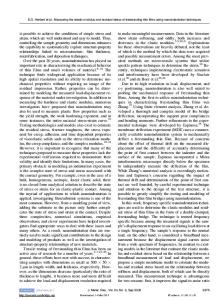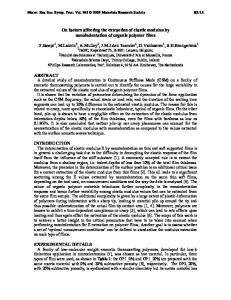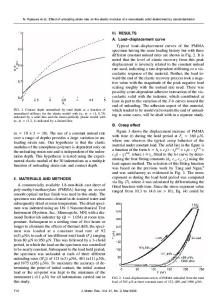A simple method for evaluating elastic modulus of thin films by nanoindentation
- PDF / 739,770 Bytes
- 15 Pages / 584.957 x 782.986 pts Page_size
- 116 Downloads / 403 Views
Hao Chen and Jian Luo School of Materials Science and Engineering, Clemson University, Clemson, South Carolina 29634
Ranran Liu and Shengmin Guo Department of Mechanical Engineering, Louisiana State University, Baton Rouge, Louisiana 70803 (Received 30 July 2008; accepted 7 October 2008)
A simple empirical method that extracts the elastic moduli of both thin films and the underlying substrates is proposed and validated by both new nanoindentation experiments and published data. Deconvolution of thin film’s elastic properties from the substrate is achieved by statistical estimation, where a simple function relating the elastic moduli of the thin film and substrate to the film-substrate composite modulus is used to fit the experimental data plotted against the logarithmic indentation depth normalized by film thickness. Experimental data from a wide range of soft and hard films on substrate were used to demonstrate the deconvolution and validate the method. The estimated elastic moduli of thin films and substrates agree well with their corresponding standard values or values obtained by other methods. The advantages of this method are discussed, and recommendations are made on how to design experiments to obtain reliable data for this method.
I. INTRODUCTION
Elastic modulus is one of the most important mechanical parameters characterizing a material’s elastic response to loading. It represents the material’s stiffness that correlates with the atomic structure, and it is essential for elastoplastic stress-strain analysis of a material subjected to various loading conditions. For macroscale bulk materials, the elastic modulus is readily determinable using standardized mechanical testing methods such as uniaxial compression or tension tests. On the other hand, determination of elastic modulus of micro- and nanoscale thin films and coatings either on substrate or as free-standing beams and membranes requires some sophisticated micro- and nanoscale characterization techniques. In fact, it has been a longstanding research focus to develop simple mechanical or physical testing techniques to determine the elastic modulus of thin films or other low-dimensional structures and materials. To date, a wide variety of such techniques have been developed. Among these are, for example, rectangular membrane load-deflection,1 microcantilever deflection,2,3 speckle interferometry,4 atomic force acoustic microscopy,5 magnetic force modulation microscopy,6 a)
Address all correspondence to this author. e-mail: [email protected]; [email protected] DOI: 10.1557/JMR.2009.0109 J. Mater. Res., Vol. 24, No. 3, Mar 2009
http://journals.cambridge.org
Downloaded: 05 Feb 2015
buckling-based method,7 instrumented indentation or nanoindentation,8–12 acoustic surface waves,13 magnetostrictive sensing,14 and combined nanoindentation and acoustic microscopy methods.15,16 Of these techniques, nanoindentation that was initially developed as an effective tool to probe the mechanical properties of small scale bulk materials has become the most widely u
Data Loading...











